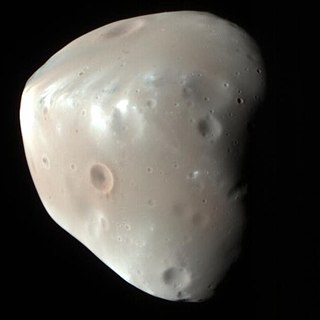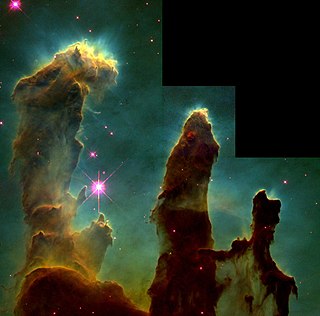
Phobos is the innermost and larger of the two natural satellites of Mars, the other being Deimos. The two moons were discovered in 1877 by American astronomer Asaph Hall. Phobos is named after the Greek deity Phobos, a son of Ares (Mars) and twin brother of Deimos.

Deimos is the smaller and outermost of the two natural satellites of Mars, the other being Phobos. Of similar composition to C and D-type asteroids, Deimos has a mean radius of 6.2 km (3.9 mi) and takes 30.3 hours to orbit Mars. Deimos is 23,460 km (14,580 mi) from Mars, much farther than Mars's other moon, Phobos. It is named after Deimos, the Ancient Greek god and personification of dread and terror.

Steven Weldon Squyres is an American astronomer and planetary scientist. He was the James A. Weeks Professor of Physical Sciences at Cornell University in Ithaca, New York. His research area is in planetary sciences, with a focus on large solid bodies in the Solar System such as the terrestrial planets and the moons of the Jovian planets. Squyres was the principal investigator of the Mars Exploration Rover Mission (MER).
The Planetary Observer program is a cancelled space exploration program designed by NASA to provide cheaper planetary orbiters by using Earth-orbiting satellite components and technology, using solar panels for power, and a common spacecraft bus platform for all Planetary Observer-class probes. Only one spacecraft of this class was eventually constructed—the Mars Observer.

Pascal Lee is co-founder and chairman of the Mars Institute, a planetary scientist at the SETI Institute, and the Principal Investigator of the Haughton-Mars Project (HMP) at NASA Ames Research Center in Mountain View, California. He holds an ME in geology and geophysics from the University of Paris, and a PhD in astronomy and space sciences from Cornell University.
David A. Hardy is a British space artist.
The International Association of Astronomical Artists (IAAA), is a non-profit organization whose members implement and participate in astronomical and space art projects, promote education about space art and foster international cooperation in artistic work inspired by the exploration of the Universe.

Sol Alan Stern is an American engineer and planetary scientist. He is the principal investigator of the New Horizons mission to Pluto and the Chief Scientist at Moon Express.

Ron Miller is an American illustrator and writer who lives and works in South Boston, Virginia. He now specializes in astronomical, astronautical and science fiction books for adults and young adults.

Rosaly M. C. Lopes is a planetary geologist, volcanologist, an author of numerous scientific papers and several books, as well as a proponent of education. Her major research interests are in planetary and terrestrial surface processes with an emphasis on volcanology.

"Space art" is the term for a genre of modern artistic expression that strives to show the wonders of the Universe. Like other genres, space art has many facets and encompasses realism, impressionism, hardware art, sculpture, abstract imagery, even zoological art. Though artists have been making art with astronomical elements for a long time, the genre of space art itself is still in its infancy, having begun only when humanity gained the ability to look off our world and artistically depicted what we see out there. Whatever the stylistic path, the artist is generally attempting to communicate ideas somehow related to space, often including an appreciation of the infinite variety and vastness which surrounds us. In some cases, artists who consider themselves space artists use more than illustration and painting to communicate scientific discoveries or works depicting space, some have had the opportunity to work directly with space flight technology and scientists in attempts to expand the arts, humanities, and cultural expression relative to space exploration.

The Lab-on-a-Chip Applications Development (LOCAD) element is a set of related lab-on-a-chip projects at NASA. The projects develop integrated lab-on-a-chip products in three areas related to space exploration: Environmental Control and Life Systems Support (ECLSS), Medical Systems, and Remote Exploration. NASA conducts activities related to these projects both at NASA Marshall Space Flight Center and aboard the International Space Station (ISS).
Don Dixon is an American astronomical artist practicing space art in the tradition of Chesley Bonestell.
Jon Lomberg is an American space artist and science journalist. He was Carl Sagan's principal artistic collaborator for more than twenty years on many projects from 1972 through 1996. In 1998, the International Astronomical Union officially named an asteroid in recognition of his achievements in science communication. He was NASA's Design Director for the Golden Record on the Voyager spacecraft; the cover he designed is expected to last at least a billion years.
The Jonathan Eberhart Planetary Sciences Journalism Award was established by the Division for Planetary Sciences to recognize and stimulate distinguished popular writing on planetary sciences. The winning author receives a prize of $1,000, plus a citation. The award is named after science journalist Jonathan Eberhart.

Luděk Pešek was a Czech artist and novelist noted for his representations of astronomical subjects. Born in Kladno in what is now the Czech Republic, he died in Stäfa, Switzerland. The asteroid 6584 Ludekpesek is named after him. He was influenced by Lucien Rudaux.

Emily Stewart Lakdawalla is an American planetary geologist and former Senior Editor of The Planetary Society, contributing as both a science writer and a blogger. She has also worked as a teacher and as an environmental consultant. She has performed research work in geology, Mars topography, and science communication and education. Lakdawalla is a science advocate on various social media platforms, interacting with space professionals and enthusiasts on Facebook, Google+ and Twitter. She has appeared on such media outlets as NPR, BBC and BBC America.
The UK Centre for Astrobiology was set up at the University of Edinburgh in 2011 by Charles Cockell. It was set up as a UK node, formally affiliated as an international partner with the NASA Astrobiology Institute (NAI) alongside other national nodes until the NAI's dissolution in 2019. It was established as a virtual centre to sit at the interdisciplinary boundary of planetary sciences/astronomy and biological/earth sciences investigating numerous aspects of life in the universe, specifically 'how habitable worlds form in the Universe and how life emerges, proliferates and leaves traces on these worlds' as well as engaging in work on the robotic and human exploration of space and in space ethics, philosophy and governance.










